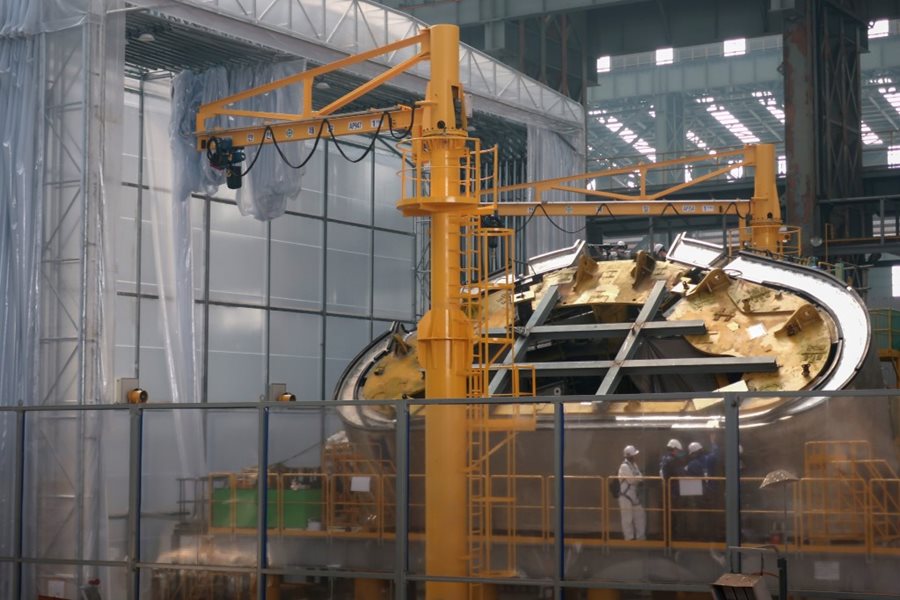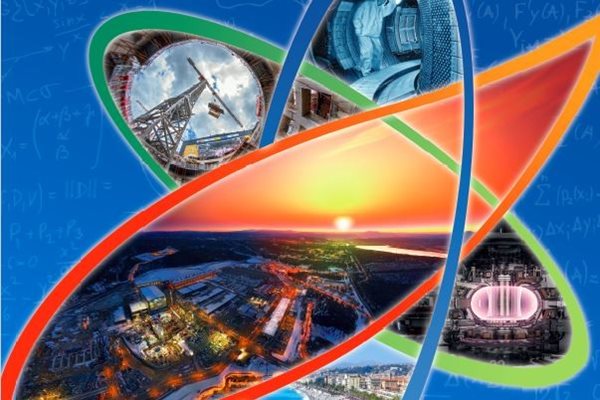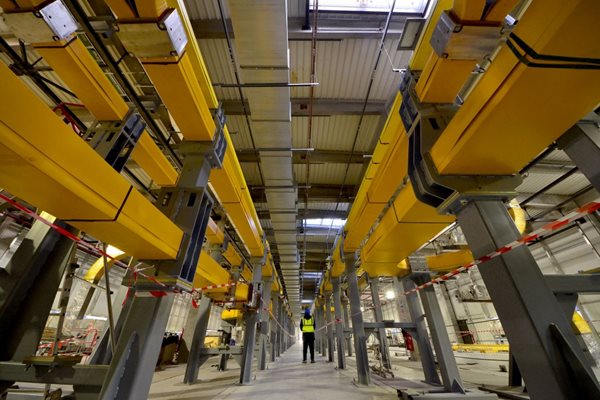
you're currently reading the news digest published from 13 Jan 2020 to 20 Jan 2020
featured3
of-interest1
press6
featured
Nuclear safety | Under constant scrutiny
Because one of the elements involved in the fusion reaction is the radioactive isotope tritium, and because the hydrogen fusion reaction itself generates a highly energetic neutron, ITER is classified as a nuclear installation—an Installation nucléaire de base (INB) in accordance with French nuclear safety regulations, which ITER observes. As for any INB in France, the construction of the installation's buildings, the manufacturing of its components and systems, assembly, and the start of each operational phase are all subject to a set of controls and authorizations. In 2012, following a complex and demanding licensing process, the French Nuclear Safety Authority (ASN) gave ITER the green light to commence construction. The Autorisation de création was delivered with three future control points that would require renewed clearance. In 2014, the first of these 'hold points'—the pouring of the Tokamak Complex basemat—was lifted. Two years later, the ASN authorized the erection of the building's north wall, which is the safety barrier between the neutral beam injector cell and the environment. Now, the project is preparing to meet the third hold point anticipated by the 2012 decree that, once lifted, will authorize the start of the machine assembly phase. Central to this last hold point is the vacuum vessel—the massive component, 20 metres across and close to 20 metres in height, which contains the plasma, collects the energy, and acts as a first safety barrier. The vacuum vessel is made of nine welded sectors, five procured by Europe and the other four by Korea. As ITER will be the first fusion installation to generate a burning plasma*, safety experts have taken a rather conservative approach to the component's design. 'We want to be certain that—whatever the intensity of the loads that the vacuum vessel will have to withstand (thermal, mechanical, electromagnetic...)—we won't risk a failure of the first confinement barrier. We have extrapolated from the loads observed in other tokamaks, particularly on JET, but in terms of plasma behaviour, ITER will be exploring new territory. We have compensated the uncertainties inherent to the ITER experiment by what we consider to be suitable margins,' explains Joëlle Elbez-Uzan, head of the ITER Environmental Protection & Nuclear Safety Division. The safety margins in ITER vacuum vessel design and construction were a condition to the issuing of the 2012 licence. So was the progressive start-up of the machine, which will provide for the careful, step-by-step monitoring of all the safety-related parameters—particularly those regarding the gauges measuring the stress exerted on the supports (or 'gussets') located under the cryostat skirt. As each vacuum vessel sector leaves the production line, the French safety authority will verify that the finalized components do not depart from the specifications that were validated prior to the Autorisation de création in 2012. For two days in December, ASN safety experts travelled to Korea in order to proceed with an in-depth inspection of vacuum vessel sector #6, which will be the first sector to reach ITER. At Hyundai Heavy Industries, the inspectors focused on both organizational and technical aspects of the component's fabrication and were satisfied with what they observed. The ASN considers that the organization of work throughout the chain of contractors is 'satisfactory and well controlled' ('satisfaisante et maîtrisée') and that 'no departure' ('pas d'écarts') from technical specifications could be noted. In consequence, no 'corrective action' was requested. The final lifting of the hold point requires a considerable number of technical demonstrations, considerable data analysis, discussion among experts, and the updating of scores of safety documents, which will keep Joëlle's team busy until the end of 2020. And even with this control point released, it will not be the end of the authorization process for the ITER installation in France. Throughout its entire life cycle, ITER will remain under constant scrutiny from the French nuclear safety authority, and several 'regulatory appointments' are already scheduled. In 2023, similar procedures will be initiated to obtain the green light for First Plasma and again in 2030 prior to full-power nuclear operation. 'What we agreed upon in 2012 was based on concepts. The more we advance in time, the closer we get to the 'final product,'' explains Joëlle. 'And of course, we need to perform some adjustments and refinements of the designs. But I'm confident in ITER's capacity to face all kinds of contingencies.' * In a burning plasma, the energy carried by the helium nuclei from the fusion reaction significantly contributes to plasma heating.
FEC 2020 | Seeking sponsors for 28th IAEA Fusion Energy Conference
For only the third time since 1961, the International Atomic Energy Agency's Fusion Energy Conference will be taking place in France—hosted jointly by the French Alternative Energies and Atomic Energy Commission (CEA) and the ITER Organization from 12 to 17 October. FEC 2020 will welcome fusion leaders, plasma physicists, experts in multidisciplinary fields, materials engineers and operators of fusion devices, as well as top-level policy makers in Nice, France. With the participation of the European Atomic Energy Community (Euratom) as well as that of more than 40 countries and dozens of research institutes, the conference aims to strengthen international collaboration and promote societal engagement in the development of fusion energy. Welcoming thousands of representatives from the global fusion community, FEC 2020 will offer a unique opportunity for organizations to raise awareness with key influencers and network among the 'crème de la crème' of the fusion community. Becoming a partner or sponsor of FEC 2020 has many advantages, such as exhibition opportunities and VIP treatment at the conference and social events. You can find information on sponsorship opportunities at this website. As a partner to FEC 2020 your contribution will allow the conference to continue as an essential meeting point for fusion energy development, and to foster continued collaboration and innovation in the field. For more information on the background of the FEC, you can also view the IAEA website here.
Power conversion | Alien structures and strange contraptions
There are places in ITER that seem to belong to another world, places full of alien structures and strange contraptions. The feeling—a mixture of awe and puzzlement—is especially acute inside the Magnet Power Converter buildings, two 150-metre-long structures located between the 400 kV electrical switchyard and the Tokamak Complex. In these vast and, for the moment, half-empty spaces, size and complexity challenge every familiar object and notion: wall sockets resemble rocket exhaust nozzles, extension cords are as thick as an overhead crane beam, switches approach the size of a small truck, and electrical cabinets have the complexity of a giant microprocessors. The twin Magnet Power Converter buildings are the ITER equivalent of a smartphone or laptop charger: their function is to convert alternative current (AC) into direct current (DC) and to feed it to the Tokamak's magnetic system. In a phone charger, however, the intensity of the current is of the order of one amp; in the Magnet Power Converter buildings it reaches 65,000 amps for the largest of the ITER magnets. Powering 10,000 tonnes of superconducting magnets requires a massive and extensive industrial infrastructure. Current from the grid must undergo a cascade of transformations before reaching the individual magnet feeders: first, the voltage is stepped down from 400 kV to 66 kV or 22 kV by the three very large transformers of the pulsed power electrical network; then, depending on which magnet the current is destined for, the voltage is transformed from 66 kV or 22 kV to approximately 1 kV by a set of 29 transformers located in concrete bays along the outside walls of the buildings. The 1 kV AC current reaches the converters inside of the buildings by way of thick metallic bars, called 'busbars,' that pass through the interior/exterior barrier through large 'wall sockets' that look like a rocket's exhaust nozzle ... Each converter is connected to a strange contraption made of stacked coils and cables—a 'reactor,' which acts like as a filter to smooth the spikes in the DC current's waveform. There are 12 such pairs in one of the building, 17 in the other, each dedicated to a specific circuit, coil, or coil module (in the case of the central solenoid). Once the DC current has been 'cleaned' by the reactor it can be fed to the magnets. However, the current intensity is such that it cannot be transported by conventional cables. Here again busbars (slightly different from the AC busbar that connect the outside transformers to the converters) will do the job. Thicker than railroad rails, the DC busbars are steel-jacketed aluminium bars insulated in epoxy wrapping and actively cooled by a constant flow of pressurized water. There are no less than 5 kilometres of busbars planned at ITER to connect electrical equipment and running half the length of each building on elevated supports. In order to reach their assigned clients (toroidal and poloidal field coils, central solenoid modules, correction coils) busbars will travel from the Magnet Power Conversion buildings to the Tokamak Building along twin 50-metre-long bridges. On the last leg of the journey, the busbar network, along with the fast discharge and switching network units, will almost fully occupy two levels of the Diagnostics Building. The busbar network installation required for First Plasma is now 92 percent complete in the first of the twin conversion buildings, and 72 percent in the other. All 32 converter units should be installed by 2021. The science-fiction décor, half-empty for the moment, will soon be packed to the brim.
of-interest
World's most powerful supercomputer to continue processing for fusion
Researchers led by CS Chang of the Princeton Plasma Physics Laboratory (PPPL) have been awarded major supercomputer time to address key issues for ITER. The award, from the DOE's INCITE* program, renews the third and final year of the team's supercomputer allocation for the current round. The third-year allotment consists of 1.5 million node hours on the Theta supercomputer at the Argonne Leadership Computing Facility, and 0.97 million node hours on Summit, the world's most powerful supercomputer, at the Oak Ridge Leadership Computing Facility. Since every computer node has thousands of processing cores, or data processors, a single node hour equals thousands of core hours. The INCITE announcement of the renewal called the studies 'time-urgent for the successful planning of ITER operation' and ones that require 'an intensive, concentrated computing effort using extreme-scale supercomputers.' The multi-year project studies three high-priority ITER edge-plasma challenges: gauging the heat-load that will strike the material surrounding the plasma in ITER; understanding the physics behind the transition from low-to-high ITER plasmas; and, studying turbulence at the edge of ITER plasmas that could damage the interior of the fusion facility. Read the full article at PPPL. *Innovative and Novel Computational Impact on Theory and Experiment (INCITE)



